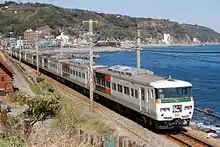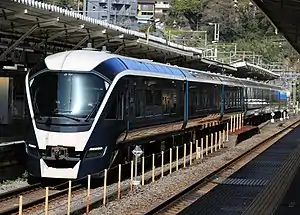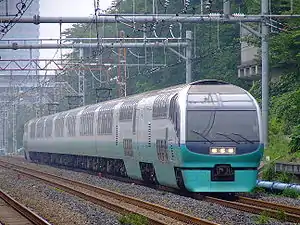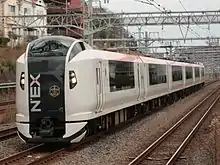Odoriko
The Odoriko (踊り子) is a limited express train service in Japan operated by East Japan Railway Company (JR East), Central Japan Railway Company (JR Central), Izukyu Corporation and Izuhakone Railway, which runs between Tokyo and Izukyū-Shimoda or Shuzenji in Shizuoka Prefecture.
 E257-2000 series Odoriko at Atami, March 2020 | |
| Overview | |
|---|---|
| Service type | Limited express |
| Locale | Tokyo, Kanagawa Prefecture, Shizuoka Prefecture |
| First service | 1 October 1981 (Odoriko) 28 April 1990 (Super View Odoriko) 14 March 2020 (Saphir Odoriko) |
| Last service | 13 March 2020 (Super View Odoriko) |
| Current operator(s) | East Japan Railway Company (JR East) Central Japan Railway Company (JR Central) Izukyu Corporation Izuhakone Railway |
| Former operator(s) | JNR |
| Route | |
| Start | Tokyo or Ikebukuro |
| End | Izukyu-Shimoda or Shuzenji |
| Line(s) used | Tōkaidō Main Line, Itō Line, Izu Kyūkō Line, Sunzu Line |
| On-board services | |
| Class(es) | Standard + Green |
| Technical | |
| Rolling stock | E257-2000 series EMU (Odoriko) E261 series EMU (Saphir Odoriko) 185 series EMU (Odoriko) isn't going to run as Odoriko on spring 2021[1] |
| Track gauge | 1,067 mm (3 ft 6 in) |
| Electrification | 1,500 V DC overhead |
| Operating speed | 110 km/h (70 mph) (Odoriko) 120 km/h (75 mph) (Saphir Odoriko) |
Summary
The Odoriko started service from October 1981, with the then-new 185 series rolling stock, replacing the earlier Amagi limited express (ran by 183 series) and the Izu express (ran by 153 series). After that, the Super View Odoriko also operated from April 1990 to 13 March 2020, with the 251 series rolling stock. On 14 March 2020, Saphir Odoriko started service using E261 series EMUs.
Regular services
Odoriko
3 services operate back and forth every day between Tokyo and Izukyu-Shimoda. 2 of which are coupled with services that go to Shuzenji (decoupled at Atami). Vending services are available between Tokyo and Ito, but aren't available aboard temporary services. Aside from that, there are temporary services originating from Shinjuku or Ikebukuro. Also, with the Ueno-Tokyo Line opening in March 2015, there are temporary services originating at Abiko, via the Joban Line;[2] and also at Omiya, via the Ueno-Tokyo Line.[3]
Stations served
- Tokyo ー Izukyu-Shimoda:
- Tokyo ー Shinagawa ー Kawasaki ー Yokohama ー Ofuna ー Odawara ー Yugawara ー Atami ー Ajiro ー Ito ー Izu-Kogen ー Izu-Atagawa ー Izu-Inatori ー Kawazu ー Izukyu-Shimoda
- Atami ー Shuzenji:
- (Coupled, and continue on towards Tokyo) ー Atami ー Mishima ー Mishima-Tamachi ー Daiba ー Izu-Nagaoka ー Ohito ー Shuzenji
Temporary services
- Ikebukuro ー Yokohama:
- Ikebukuro ー Shinjuku ー Musashi-Kosugi ー Yokohama ー (Continue on towards Izukyu-Shimoda)
- Abiko ー Tokyo:
- Abiko ー Kashiwa ー Matsudo ー Kita-Senju ー Ueno ー Tokyo ー (Continue on towards Izukyu-Shimoda)
- Omiya ー Tokyo:
- Omiya ー Urawa ー Akabane ー Ueno ー Tokyo ー (Continue on towards Izukyu-Shimoda)

Formation
Services are operated by 5, 7, 5+7, 10 and 10+5-car 185 series EMUs. The 15 car formation makes the Odoriko the longest Limited Express train running in Japan (excluding shinkansen trains).[4] They are formed as follows, with car 1 at the Izukyū-Shimoda/Shuzenji end.
| Car No. | 1 | 2 | 3 | 4 | 5 | 6 | 7 | 11 | 12 | 13 | 14 | 15 |
|---|---|---|---|---|---|---|---|---|---|---|---|---|
| Accommodation | Reserved | Reserved | Reserved | Green | Reserved | Non-reserved | Non-reserved | Non-reserved | Non-reserved | Reserved | Reserved | Reserved |
| Set | Basic set | Additional set | ||||||||||
| Car No. | 1 | 2 | 3 | 4 | 5 | 6 | 7 | 8 | 9 | 10 | 11 | 12 | 13 | 14 | 15 |
|---|---|---|---|---|---|---|---|---|---|---|---|---|---|---|---|
| Accommodation | Reserved | Reserved | Reserved | Green | Green | Reserved | Reserved | Reserved | Non-reserved | Non-reserved | Non-reserved | Non-reserved | Reserved | Reserved | Reserved |
| Set | Basic set | Additional set | |||||||||||||
Saphir Odoriko

The Saphir Odoriko commenced operations on 14 March 2020 to replace the Super View Odoriko as an ultra-deluxe version of the regular Odoriko. One Saphir Odoriko service runs to and from Tokyo station daily. During the peak travel season, an additional service runs from Tokyo, and another runs from Shinjuku.
Stations served
Tokyo - Izukyu-Shimoda
Tokyo - Shinagawa - Yokohama - Atami - Ito - Izu-Kogen - Izu-Atagawa -Izu-Inatori - Kawazu - Izukyu-Shimoda
Shinjuku - Izukyu-Shimoda
Shinjuku - Shibuya - Musashi-Kosugi - Yokohama - Atami - Ito - Izu-Kogen - Izu-Atagawa - Izu-Inatori - Kawazu - Izukyu-Shimoda
Formation
Trains are operated by E261 series trainsets. The trains feature all Green Cars, with Car 1 designated as a 'Premium Green Car' with 2 large reclining seats per row.[5]
The Saphir Odoriko does not operate from Ikebukuro, Omiya or Abiko as the former Super View Odoriko used to. These services were consolidated with the regular Odoriko services.[6][7]
Temporary services

Resort Odoriko
The Resort Odoriko (リゾート踊り子) is a temporary service, which operates between Tokyo and Izukyū-Shimoda. The service normally consists of one outbound journey to Izukyu-Shimoda at special holidays only.[4]
Stations served
- Tokyo ー Izukyu-Shimoda:
- Tokyo ー Yokohama ー Ofuna ー Odawara ー Yugawara ー Atami ー Ajiro ー Ito ー Izu-Kogen ー Izu-Atagawa ー Izu-Inatori ー Kawazu ー Izukyu-Shimoda
Formation
Resort Odoriko services operate using Izukyū 2100 series "Resort 21" 8-car EMUs, formed as shown below, where car 1 at the Izukyū-Shimoda end, and car 8 at the Tokyo end.
| Car No. | 1 | 2 | 3 | 4 | 5 | 6 | 7 | 8 |
|---|---|---|---|---|---|---|---|---|
| Accommodation | Reserved, Observation deck | Reserved | Reserved | Reserved | Green | Reserved | Reserved | Reserved, Observation deck |
Former services
Super View Odoriko
The Super View Odoriko (スーパービュー踊り子) was the first deluxe version of the Odoriko operated from 28 April 1990 to 13 March 2020.[8][7] It used 251 series 10-car EMUs and runs between Tokyo or Ikebukuro and Izukyū-Shimoda.[4] The service was originally scheduled to commence from the start of the revised timetable on 10 March 1990, but rolling stock delivery delays meant that services were substituted by regular Odoriko services using 185 series EMUs.[8]
On weekdays, one train operated from Shinjuku to Izukyu-Shimoda, 2 trains operated back and forth between Tokyo and Izukyu-Shimoda, and one train operated from Izukyu-Shimoda to Ikebukuro each day.
On weekends, the Shinjuku-originating train changed originating station to Ikebukuro. Aside from that, services from Shinjuku to Izukyu-Shimoda and from Izukyu-Shimoda to Tokyo operated once a day. Moreover, during busy seasons, there were numerous extra services, with one extended service between Omiya and Izukyu-Shimoda, which ran along the Shonan-Shinjuku Line from Omiya to Yokohama; 2 trains from Tokyo to Izukyu-Shimoda, with only 1 returning to Tokyo; and one train from Izukyu-Shimoda to Shinjuku.
Stations served
Stations in brackets meant that some services made stop there.
- Tokyo ー Izukyu-Shimoda:
- Tokyo ー (Shinagawa) ー Yokohama ー (Odawara) ー (Yugawara) ー Atami ー (Ajiro) ー Ito ー Izu-Kogen ー Izu-Atagawa ー Izu-Inatori ー Kawazu ー Izukyu-Shimoda
- Only Super View Odoriko No. 5 and No. 8 stopped at Shinagawa.
- Only Super View Odoriko No. 2 and No. 11 stopped at Odawara, Yugawara and Ajiro.
- Ikebukuro ー Yokohama:
- Ikebukuro ー Shinjuku ー Musashi-Kosugi ー Yokohama ー (Continue on towards Izukyu-Shimoda)
Temporary services

Formation
Super View Odoriko trains were operated with 251 series trains, with cars 1, 2 and 10 being double decker cars. Trains were formed as follows, with car 1 at the Izukyū-Shimoda end, and car 10 at the Tokyo and Shinjuku end.
| Car No. | 1 | 2 | 3 | 4 | 5 | 6 | 7 | 8 | 9 | 10 |
|---|---|---|---|---|---|---|---|---|---|---|
| Numbering | KuRo 250 | SaRo 251 | MoHa 250 | MoHa 251-100 | MoHa 250-100 | MoHa 251 | MoHa 250 | MoHa 251 | SaHa 251 | KuHa 251 |
| Accommodation | Green, Observation deck | Green | Reserved | Reserved | Reserved | Reserved | Reserved | Reserved | Reserved | Reserved, Observation deck |
| Green Car exclusive lounge | Compartments | Children's play area |
Marine Express Odoriko
From 1 December 2012, seasonal Marine Express Odoriko (マリンエクスプレス踊り子) services were introduced, running between Tokyo and Izukyū-Shimoda. The service normally consisted of one return journey at weekends only.[9] JR East announced that from the start of the revised timetable on 14 March 2020, Marine Express Odoriko services would be discontinued as they were surplus to requirements.[10]

Stations served
- Tokyo ー Izukyu-Shimoda:
- Tokyo (Tokaido Line Platform) ー Yokohama ー Atami ー Ito ー Izu-Kogen ー Izu-Atagawa ー Izu-Inatori ー Kawazu ー Izukyu-Shimoda
Formation
Marine Express Odoriko services operated using E259 series 6-car EMUs normally used on Narita Express services. The formation is shown below, where car 1 at the Izukyū-Shimoda end, and car 6 at the Tokyo end.
| Car No. | 1 | 2 | 3 | 4 | 5 | 6 |
|---|---|---|---|---|---|---|
| Accommodation | Reserved | Reserved | Reserved | Reserved | Reserved | Green |
History
The limited express service was inaugurated on 1 October 1981 following the introduction of the then-new 185 series EMUs, replacing the earlier Amagi limited express and Izu express services from Tokyo to Izu.[11]
 An Odoriko service in 1982 formed of a 183 series EMU
An Odoriko service in 1982 formed of a 183 series EMU EF58 61 hauling the Limited Express Odoriko at Ofuna station
EF58 61 hauling the Limited Express Odoriko at Ofuna station
The Superview Odoriko operated from April 1990[12] until 13 March 2020. The Saphir Odoriko has been operating since 14 March 2020.[13]
Future development
Since the current rolling stock, the 185 series is aging, there are plans to replace those rolling stock.
The 185 series are beginning to be replaced by new E257-2000 series trains that used to operate Azusa and Kaiji limited express services on the Chuo Main Line, and were replaced by E353 series trains. JR East plans to have all 185 series trains operating on the Odoriko service replaced by March 2021.[14]
JR East has also announced changes to the reserved seating on Odoriko services coinciding with the full retirement of 185 series EMUs from the service. Trains will now use LED seat reservation status indicators, rather than having dedicated non-reserved seat cars. This is the same system used by limited express services on the Chūō Line and Jōban Line. There will two types of such supplementary tickets in the new system, namely the Reserved Seat Ticket (座席指定券, Zaseki shitei ken), and the Unreserved Seat Ticket (座席未指定券, Zaseki mishitei ken). The Unreserved Seat Ticket will replace Non-reserved Seat tickets (自由席券, Jiyūseki ken), which currently allow use of non-reserved cars.[15]
The Reserved Seat Ticket enables a specified seat to be reserved for the holder. The reserved status for the seat is signified by a green overhead lamp on top of the corresponding seat.
The Unreserved Seat Ticket enables the holder to be seated on any unreserved seat. A red overhead lamp signifies that the seat is unreserved; while a yellow overhead lamp signifies that the seat is reserved for the later part of the journey, implying that one has to give up their seat to the passenger who has reserved the seat, when they board the train later.
Additionally, Tōkaidō Shinkansen passengers currently receive a discount if they transfer to an Odoriko service. This will be discontinued in March 2021.
Namesake
The word odoriko means dancing girl in Japanese. The train service was named after the title of novel Izu no Odoriko (The Dancing Girl of Izu) by Yasunari Kawabata. The stage of the novel is the destination of the train, Izu Peninsula.
There are numerous services operating between Tokyo and the Izu Peninsula, which had all been discontinued and became the Odoriko limited express today.
- Amagi「あまぎ」, named after Mount Amagi, the mountain at the center of the Izu Peninsula
- Ikoi「いこい」, derived from the Japanese verb "ikou" (憩う, いこう), which literally means to relax and rest (In this case, relax in the local onsens at Izu)
- Izu「伊豆」, named after the Izu Peninsula, and also the former Izu Province
- Ideyu「いでゆ」, meaning hot springs, which are prominent at Izu
- Okuizu「おくいず」, referring to the inner part (i.e. the southern part) of Izu.
- Olympia「オリンピア」, referring to the Olympic Games
- Jukkoku「十国」, named after the Jukkoku Pass, a ridge between Atami and Kannami. The pass is called "Jukkoku" (literally: 10 provinces), because from there, 10 provinces can actually be viewed, namely Sagami, Musashi, Awa, Kazusa, Shimosa, Suruga, Totomi, Shinano, Kai and Izu Provinces.
- Shonan-Nikko「湘南日光」, as this former service links the Shonan region to Nikko
- Joban-Izu「常磐伊豆」, as this former service links Izu to the Joban region (常磐地域), which refers to the combined region of the former Hitachi Province (常陸国) and the Iwaki Province (磐城国), to Izu
- Tachibana「たちばな」, Japanese for mandarin oranges, which is a major agricultural product at Izu.
- Chiyoda「ちよだ」, named after the Chiyoda district, where the Imperial Palace is located.
- Hatsushima「はつしま」, named after Hatsushima, an island 10 km east of Atami
References
- JR Timetable, March 2008 issue
- Satō, Yoshihiko (June 1990). "スーパー・リゾートトレイン JR東日本251系 "スーパービュー踊り子"" [Super resort train: JR East 251 series Super View Odoriko]. Japan Railfan Magazine. Vol. 30. Japan: Kōyūsha Co., Ltd. p. 13.
- Ōkuma, Takao (February 2008). "185系電車の登場の背景とそのメカニズム" [Background to the arrival of the 185 series EMU]. Tetsudō Daiya Jōhō Magazine. Vol. 37. Japan: Kōtsū Shimbun. pp. 12–46.
- announcement of discontinuing to use type 185 on 12 November 2020
- "JR East Press Release "About spring extra services"" (PDF). 23 January 2015.
- "JR East Press Release "About summer extra services"" (PDF). 22 May 2015.
- JR新幹線&特急列車ファイル [JR Shinkansen & Limited Express Train File]. Japan: Kōtsū Shimbun. 2008. ISBN 978-4-330-00608-6.
- 新型の観光特急列車 初の全車両グリーン席 (New sightseeing limited express, first train ever with all green cars) Mainichi Shimbun, 8 May 2018
- https://web.archive.org/web/20191213080612/https://www.jreast.co.jp/press/2019/20191213_ho01.pdf (About the March 2020 schedule revision) JR East, 13 December 2019
- https://www.jreast.co.jp/press/2019/yokohama/20200228_y01.pdf (Superview Odoriko last run and photo opportunity) 28 February 2020
- JR特急10年の歩み [10 Years of JR Limited Express Trains] (in Japanese). Japan: Kousai Shuppansha. May 1997. pp. 49–50. ISBN 4-330-45697-4.
- 冬の増発列車のお知らせ [Details of additional winter trains] (PDF). News release (in Japanese). Japan: East Japan Railway Company. 19 October 2012. Retrieved 22 October 2012.
- マリンエクスプレス踊り子運転終了 [Marine Express Odoriko operation end]. News release (in Japanese). Japan: Japan Railfan Magazine. 9 March 2020. Retrieved 14 March 2020.
- Miyake, Toshihiko (December 2011). "伊豆への優等列車のあゆみ" [History of premier trains to Izu]. Tetsudō Daiya Jōhō Magazine. Vol. 40 no. 332. Japan: Kōtsū Shimbun. pp. 24–31.
- Jēāru zensharyō handobukku: Rail Magazine 2009 JR全車輌ハンドブック2009 [JR Rolling Stock Handbook 2009]. Japan: Neko Publishing. 2009. ISBN 978-4-7770-0836-0.
- "特急"サフィール踊り子"が運転を開始" [Limited express "Saphir Odoriko" starts operation]. Japan Railfan Magazine Online (in Japanese). Japan: Koyusha Co., Ltd. 15 March 2020. Archived from the original on 15 March 2020. Retrieved 15 March 2020.
- https://web.archive.org/web/20170409201118/http://mainichi.jp/articles/20170408/k00/00e/020/316000c
External links
| Wikimedia Commons has media related to Odoriko (train). |
- JR East 185 series Odoriko (in Japanese)
- JR East 251 series Super View Odoriko (in Japanese)
.svg.png.webp)